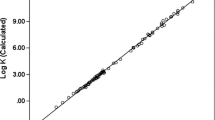Summary
An equation is proposed to determine the value of the partial molar enthalpy of solution of the substance under investigation from its retention indices. The values of the enthalpy of solution obtained for benzene, cyclohexane, diethylsulfide, di-n-propylsulfide, dimethyldisulfide, diethyldisulfide, n-propylmercaptan, n-butylmercaptan in apiezon-M and polyethyleneglycol-1000 have been for the first time determined by two methods: through the specific retention volumes and by means of our equation.
The dependence of the partial molar ethalpy of solution and evaporation of n-hydrocarbons on the number of carbon atoms has been investigated. It has been experimentally shown that the homological difference between the enthalpy of evaporation and that of solution is practically equal in absolute value, amounting to ⋟ 1 kcal/mole.
Zusammenfassung
Es wurde eine Gleichung vorgeschlagen, die es erlaubt, die Größe der partiellen molaren Lösungsenthalpie des zu untersuchenden Stoffes aus seinen Retentionsindices zu errechnen.
Es wurde die Größe der Lösungsenthalpien von Benzol, Cyclohexan, Diäthylsulfid, Di-n-propylsulfid, Dimethyldisulfid, Diäthyldisulfid, n-Propylmercaptan, n-Butylmercaptan auf APIEZON-M und PEG-1000 durch zweierlei Methoden festgestellt: Auf Grund der spezifischen Retentionsvolumina und mit Hilfe der von uns vorgeschlagenen Gleichung.
Es wurde die Abhängigkeit der partiellen molaren Lösungs-und Verdampfungsenthalpien der n-Kohlenwasserstoffe von der Zahl der Kohlenstoffatome geprüft und gezeigt, daß die homologen Differenzen zwischen den Lösungs-und Verdampfungsenthalpien sich fast entsprechen und ⋟ 1 kcal/mol betragen.
Sommaire
On propose une équation qui permet la détermination de la valeur de l'enthalpie molaire partielle de solution des substances à partir des indices de rétention.
Pour la première fois, les valeurs de l'enthalpie de solution pour le benzène, le cyclohexane, le thio-ether diéthylique, le thio-ether di-n-propylique, le diméthylmercaptan, le disulfide diéthylmercaptan, le n-propylmercaptan, et le n-butylmercaptan sur Apiezon-M et polyéthylène-glycol 1000 ont été déterminées par deux méthodes: sur la base des volumes de rétention spécifiques, et à l'aide de notre équation.
La relation entre l'enthalpie molaire partielle de solution et l'évaporation des hydrocarbures linéaires suivant le nombre d'atomes de carbone a été étudiée. On a démontré expérimentalement que la différence entre homologues pour l'enthalpie d'évaporation et celle de solution sont pratiquement égales en valeur absolue, celle-ci étant d'environ 1 kcal/mole.
Similar content being viewed by others
References
E. Kováts, Helv. chim. acata,42 (1959) 2712.
Recommendations of the Data Sub-Committee for the Publication of Retention Data, J. Gas. Chromatog.,3 (1965) 296.
J. Takács, M. Rockenbauer, I. Olássi, J. Chromat.,42, (1969) 19.
J. Gas. Chromat.,4 (1966) 1–3.
R. Hatch, J. Gas. Chromat.,6 (1969) 611.
W. O. McReynolds, “Gas Chromatographic Retention Data”, Heyden & Son Ltd, London 1967.
E. Kováts, P. B. Weiss, Ber. dtsch. Bunsenges.69 (1965) 812.
E. Kováts, “Advances in Chromatography”, vol. I,J. C. Giddings andR. A. Keller, eds., Marcel-Dekker, New York 1965, p. 229.
H. Strickler, E. Kováts, J. Chromat.,8 (1962) 289.
S. D. Nogare, R. S. Juvet, “Gas-liquid chromatography”, Interscience Publishers, New York, London 1962.
“Fiziko-khimicheskiye svoistva individualnikh uglevodorodov”. Redaktor:V. M. Tatiyevsky, Moscow, 1960.
M. L. Peterson, J. Hirsch, J. Lipid Res.,1 (1959) 132.
D. H. Desty, W. T. Swanton, J. Phys. Chem.,65 (1961) 766.
R. V. Golovnya, V. P. Uralets, Izv. AN SSSR, ser. khim.,1 (1967) 185.
A. B. Littlewood, Anal. Chem.,36 (1964) 1441.
E. Cremer, H. L. Cruber, J. Gas. Chromat.,3 (1965) 8.
D. W. Barber, C. S. G. Phillips, G. F. Tusa, A. Verdin, J. Chem. Soc., 1959, 18.
S. H. Langer, B. M. Johnson, J. R. Conder, J. Phys. Chem.,72 (1968) 4020.
Author information
Authors and Affiliations
Additional information
Translated by A. L. Pumpiansky, Moscow.
Rights and permissions
About this article
Cite this article
Golovnya, R.V., Arsenyev, Y.N. Gas chromatographic method for determination of enthalpy of solution from retention indices. Chromatographia 3, 455–461 (1970). https://doi.org/10.1007/BF02268395
Received:
Accepted:
Issue Date:
DOI: https://doi.org/10.1007/BF02268395



